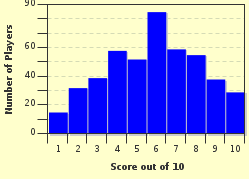Quiz Answer Key and Fun Facts
1. Ecology is, if you excuse the pun, littered with very precise definitions which have more generic meanings in everyday language. Such an example is the use of the word 'population'. Which of the following best describes the ecological use of the word 'population'?
2. The specificity of terminology tends to be the hardest concept to grasp in ecology. However, there is an ecological term that has a very similar meaning to its everyday counterpart. Which of these terms is defined as 'the role of a particular species in its environment'?
3. Ecology is primarily concerned with the interactions of organisms and the environment. What name is given to the phenomenon whereby a species will inhabit a hostile environment, die and provide nutrients; this in turn allows a greater variety of species to inhabit and survive in the area?
4. What ecological name is given to species that are the first to establish a population in a particular habitat? Initially, the habitat is generally harsh with extreme abiotic factors such as water and pH.
5. After a series of ecological changes, an initially hostile, barren area can become a thriving habitat with a great diversity of species. Eventually a stable community is formed, but, what is the name given to this final stage of ecological development?
6. To monitor the diversity of plant populations in particular areas, a simple piece of equipment is used. What is the name given to a, usually four sided, frame which encloses a representative sample?
7. It has long been known that earthworms are a gardener's delight. They are often perfect for the soil and somewhat clean up the garden by feeding on dead materials such as leaf litter. Due to this they, and other organisms like them, are known as saprophages. As a result, ecologists discovered that there are more than one type of food chain. The first of which is a grazing food chain, the other is known as what?
8. Ecology goes hand in hand with botany, the study of plants. Green plants are generally found at the bottom of a food chain or at the bottom trophic level (feeding level).
Organisms, such as plants, that produce their own food (self-feed) are called heterotrophic.
9. Ecologists are very much interested in ascertaining the populations of particular habitats. They do this by what is known as the 'mark - release - recapture' technique which is exactly what it says on the tin. They capture and discreetly mark the organisms, release them and recapture them. All this allows them to carry out a calculation to estimate the size of the population. What is the name of the index used in this calculation?
10. Ecologists use many different types of indices to discover the great network of relationships in the scientific discipline. Which of the following indices is also known as the index of diversity?
Source: Author
jonnowales
This quiz was reviewed by FunTrivia editor
crisw before going online.
Any errors found in FunTrivia content are routinely corrected through our feedback system.

